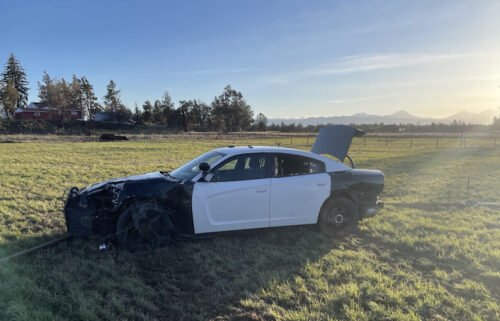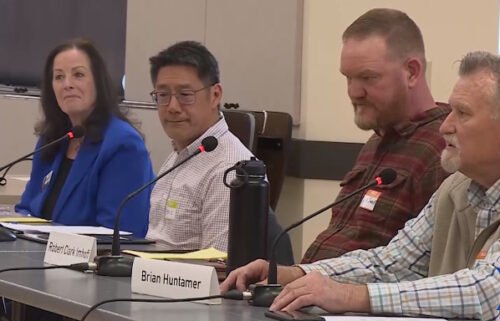Soaring house prices create a new crisis in Australia

People walk along the Esplanade at Surfers Paradise in Gold Coast
By Hilary Whiteman, CNN
Faye sits on a couch, her long hair twisted into a gray braid that comes down to her waist.
Her pale blue eyes fill with tears as she describes how she became homeless and her terror of what may happen if she’s not able to find a permanent place to stay.
“I’ll be happy if I can just get a little roof over my head,” Faye says, pausing to correct herself. “A safe roof over my head.”
At 72, the great-grandmother never thought she’d be here — in a bare-walled flat in emergency accommodation on the Gold Coast of Australia — but life hasn’t worked out as she hoped it would.
She once owned her own home, had a husband and two children, but found herself without enough savings to cushion her against unexpected events later in life: poor health, unemployment, abuse, divorce.
Faye, who is using an alias for privacy reasons, is part of the fastest growing group of homeless people in Australia: women over 55. Older women made up a relatively small proportion of the 116,000 people who reported themselves homeless during the last national Census night in 2016. Most were young and living in “severely crowded” homes — houses that would need at least four extra bedrooms to cater for the number of people living there.
But at the time, researchers noted a rapid rise in the number of older homeless women — up 31% in five years — and experts say there’s no sign the trend has slowed. If anything, it has worsened due to job losses during the pandemic, rising rental costs and soaring inflation.
For decades, women worldwide have earned less money than men — a disparity known as the gender wage gap. Now with fewer retirement savings, thousands of Australian women are finding themselves without a safe space to sleep at night. On Saturday, Australians will vote in a federal election — and housing has emerged as a key issue.
How a life falls apart
There was nothing unusual about Faye’s life. She married a man, they bought a house and had two children. But when the children were in primary school, she said her husband “played up on her” — cheated — and moved in with the other woman.
Faye tried to make it work as a single mother, but eventually she and the children had to move in with her parents. “I ended up selling the house. And he took most of it anyway,” she said of her ex-husband.
She then met another man who was out of work and bought him a business, which he ran into the ground. Faye didn’t get her money back. When her next partner became violent, she fled, leaving everything behind.
Faye has been supported by some family members, but nobody has the space to take her in. Besides, she doesn’t want to be a strain. “You don’t want to be a burden to people, you know, because you’re older,” she said. “You can’t stay with people. You just can’t. You’re in the way.”
Low interest rates have pushed Australian house prices to record highs. On the Gold Coast, where Faye lives, some homeowners have sold up to cash in their profits, displacing long-term renters. The coastal city, south of Brisbane, has become a popular destination for people moving north from southern states that suffered bigger Covid outbreaks. Recent floods have also added to demand for accommodation.
The rental market is now tighter than ever, and people like Faye, who receive the age pension — almost 1,000 Australian dollars ($697) a fortnight for people aged 66 years and six months or over — struggle to afford to rent in the private sector.
The median weekly rent for a two-bedroom apartment in the central Gold Coast is 644 Australian dollars ($448). Anyone who’s spending over 30% of their income on accommodation is considered to suffer “rental stress,” so estate agents typically won’t approve their applications, but there are very few other options.
As of 2021, the average wait for social housing on Australia’s Gold Coast was over 3.5 years.
While most Australians will save for retirement by paying into a scheme which requires employers to contribute to their pension pot, Elise Klein, a senior lecturer in public policy at the Australian National University, says structural inequalities, such as the gender wage gap, mean that many women don’t have enough of their own savings to support themselves in retirement.
According to the Workplace Gender Equality Agency, women in Australia earn on average $255.30 ($178) a week less than men. Time out of work to care for children also limits their retirement savings.
Some older women can lean on their partners for financial support, but many don’t have that option. “It shouldn’t be a situation where a woman’s choice to be a single woman is a defining marker of if she’s going to have a house over her head or not,” Klein said. “But it is a major contributor to homelessness, because of the ways in which the economy is structured to completely undervalue unpaid care work.”
Shut out of the market
In Australia, owning your own home can mean the difference between a comfortable retirement and homelessness, according to research from independent think tank the Grattan Institute.
“Half of all renters retire in poverty compared to less than 10% of homeowners,” said Brendan Coates, director of the institute’s economic policy program.
Coates added that following a divorce, fewer women than men buy another home, partly because banks evaluate loans on the size of the deposit and ongoing earnings. As women earn less, they’re likely to be offered a smaller loan — if any at all — so some are shut out of the market.
Older renters can run into trouble if they lose their jobs before the retirement age of 66 years and six months, Coates added. Then, they may have to survive on unemployment benefits, which are even lower than the age pension.
Faye retired early after suffering a brain aneurism requiring surgery in her early 60s. By the time she had recovered, she was too frail to stand for hours behind the till working as a retail assistant. Today, her most valuable possession is her car, but she now hopes to sell it for 2,000 Australian dollars ($1,393) to help pay for food and other expenses. Partly as a result of the war in Ukraine, inflation is at 20-year high in Australia and the cost of most daily items is rising, including fuel.
Voting for change?
The housing crisis has been building in Australia for years as house prices surged, making it harder for people to save a deposit.
On Sunday, Prime Minister Scott Morrison entered the final week of the election campaign with a promise to allow some people to dip into their retirement savings to get into the market. His Labor rival Anthony Albanese says, if elected, his government will top-up the deposit for a small number of first-time buyers.
Both policies created headlines, but their pitch to women voters was more low-key. Morrison says, if re-elected, his government will allow working parents to share up to 20 weeks of paid parental leave. Albanese is promising to increase childcare subsidies to get more women back to work. Both are offering more support for victims of domestic and family violence, though only Labor has committed to backing a new policy of 10 days leave for victims of family violence.
Morrison has touted his party’s past success in reducing the gender wage gap, while Albanese says he’ll make it easier to force companies to pay women more.
Whoever wins Saturday’s election, women’s rights campaigners and charity workers say much more needs to be done to level the playing field — and not just through policies.
“There’s still a systemic attitude around who is the main breadwinner, and who is able to be financially independent,” said Cherylee Treloar, the CEO of Footprints, a non-profit community group that supports people at risk of homelessness. “That concept of women being able to be financially independent is still something that there’s a psychological resistance to in Australia.”
Last year, thousands of Australians joined the “March for Justice,” a campaign that started with a call for women’s safety and grew into a wider campaign for gender equality.
One year on, the movement’s co-founder Janine Hendry said politicians have still not done enough to address longstanding issues. “We’re talking about the gender pay gap, but we’re not really talking about the overall economic insecurity that is occurring for women as a result of inequality,” she said. This includes women like Faye.
Back on the Gold Coast, Faye says she plans to vote in the election despite not having a fixed address — voting is compulsory in Australia. She’s not sure who she’ll vote for but has a simple request.
“I just want somebody that’s going to do the best for the country, and for everybody.”
Credits
Illustrations: Natalie Leung and Claire Manibog
Story editors: Eliza Anyangwe and Meera Senthilingam
The-CNN-Wire
™ & © 2022 Cable News Network, Inc., a WarnerMedia Company. All rights reserved.



